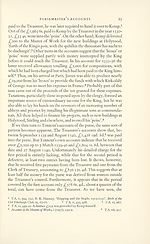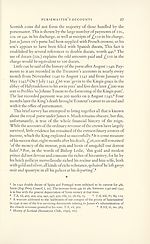Series 4 > Miscellany of the Scottish History Society
(51) Page 26
Download files
Complete book:
Individual page:
Thumbnail gallery: Grid view | List view

26
MISCELLANY X
Treasurer made no payments at all to the purse in the three years
preceding September 1539.
Though it is possible to ascertain what proportion of Tennent’s
receipts was derived from the Treasurer, it is more difficult to deter¬
mine whence came the remainder. The -£200 received from John and
Patrick Grant on 5 March 1539-40 was almost certainly the gressum
or composition on feu-charters granted by the bishop of Moray to
John Grant of Ballindalloch and his brother, to which Tennent was a
witness. This sum, which appears to have been handed over intact to
the King the following day, was refunded to the Bishop by the
Treasurer before the end of the month.1 On 26 July 1540 Tennent
received ;£110 from the abbot of Melrose. This was probably part of
the sum of -£159, arrears of the ‘great tax’ imposed on the clergy, for
which the King granted a discharge to the abbot on 24july 1540.2 The
remaining items in the charge produce an added complication. Evi¬
dently there were two purses: the ‘purse of expenses’, kept by Ten¬
nent, and the ‘playe purse’. On at least eleven occasions the ‘purse of
expenses’ was supplied with money out of the ‘playe purse’, amounting
to over -£600. The term ‘playe purse’ is completely obscure, no refer¬
ence to it appearing in any other source. Perhaps it contained the
King’s winnings at cards or gaming. On the other hand, four of the
payments amounted to ^110 and a fifth to £120, which would indi¬
cate an unusual amount of gambler’s luck, even for a king. Smaller
amounts do appear, but as four such payments are recorded on the
same day, 30 March 1540, this may be no more than a matter of book¬
keeping, whereby separate entries were made for different types of
coins.
Some of the coins mentioned were English: angel nobles (valued
at30s. Scots), Harry nobles (48s.) and rose nobles (53s.). There are also
references to Scottish groats, ‘riders’ and ‘unicorns’. On 27 July 1540
the pursemaster was given sixty of the newly minted ducats or
‘bonnet pieces’, worth three merks (40s.) each. On 27 August he
received another four of these, as well as some of the smaller ‘bonnet
pieces’, namely eight ‘twa part’ (2-3rd) ducats (two merks) and six
‘thrid part’ (i-3rd) ducats (one merk).3 It appears, however, that
1 Moray Registrum, nos. 308, 343; TA, vii, 297.
2 Acts of the Lords of Council in Public Affairs, ed. R. K. Hannay (1932), 492.
3 Below, p. 32, n. 6. See also illustration of a ‘bonnet piece’, p. 11.
MISCELLANY X
Treasurer made no payments at all to the purse in the three years
preceding September 1539.
Though it is possible to ascertain what proportion of Tennent’s
receipts was derived from the Treasurer, it is more difficult to deter¬
mine whence came the remainder. The -£200 received from John and
Patrick Grant on 5 March 1539-40 was almost certainly the gressum
or composition on feu-charters granted by the bishop of Moray to
John Grant of Ballindalloch and his brother, to which Tennent was a
witness. This sum, which appears to have been handed over intact to
the King the following day, was refunded to the Bishop by the
Treasurer before the end of the month.1 On 26 July 1540 Tennent
received ;£110 from the abbot of Melrose. This was probably part of
the sum of -£159, arrears of the ‘great tax’ imposed on the clergy, for
which the King granted a discharge to the abbot on 24july 1540.2 The
remaining items in the charge produce an added complication. Evi¬
dently there were two purses: the ‘purse of expenses’, kept by Ten¬
nent, and the ‘playe purse’. On at least eleven occasions the ‘purse of
expenses’ was supplied with money out of the ‘playe purse’, amounting
to over -£600. The term ‘playe purse’ is completely obscure, no refer¬
ence to it appearing in any other source. Perhaps it contained the
King’s winnings at cards or gaming. On the other hand, four of the
payments amounted to ^110 and a fifth to £120, which would indi¬
cate an unusual amount of gambler’s luck, even for a king. Smaller
amounts do appear, but as four such payments are recorded on the
same day, 30 March 1540, this may be no more than a matter of book¬
keeping, whereby separate entries were made for different types of
coins.
Some of the coins mentioned were English: angel nobles (valued
at30s. Scots), Harry nobles (48s.) and rose nobles (53s.). There are also
references to Scottish groats, ‘riders’ and ‘unicorns’. On 27 July 1540
the pursemaster was given sixty of the newly minted ducats or
‘bonnet pieces’, worth three merks (40s.) each. On 27 August he
received another four of these, as well as some of the smaller ‘bonnet
pieces’, namely eight ‘twa part’ (2-3rd) ducats (two merks) and six
‘thrid part’ (i-3rd) ducats (one merk).3 It appears, however, that
1 Moray Registrum, nos. 308, 343; TA, vii, 297.
2 Acts of the Lords of Council in Public Affairs, ed. R. K. Hannay (1932), 492.
3 Below, p. 32, n. 6. See also illustration of a ‘bonnet piece’, p. 11.
Set display mode to:
![]() Universal Viewer |
Universal Viewer | ![]() Mirador |
Large image | Transcription
Mirador |
Large image | Transcription
Images and transcriptions on this page, including medium image downloads, may be used under the Creative Commons Attribution 4.0 International Licence unless otherwise stated. ![]()
| Scottish History Society volumes > Series 4 > Miscellany of the Scottish History Society > (51) Page 26 |
|---|
| Permanent URL | https://digital.nls.uk/126693495 |
|---|
| Description | Over 180 volumes, published by the Scottish History Society, containing original sources on Scotland's history and people. With a wide range of subjects, the books collectively cover all periods from the 12th to 20th centuries, and reflect changing trends in Scottish history. Sources are accompanied by scholarly interpretation, references and bibliographies. Volumes are usually published annually, and more digitised volumes will be added as they become available. |
|---|


